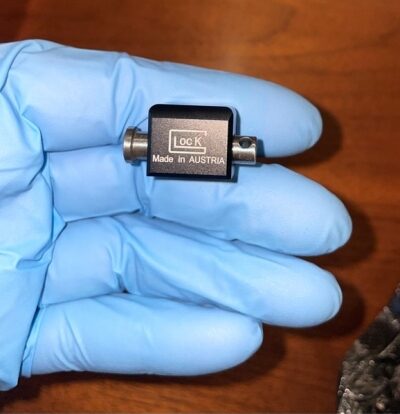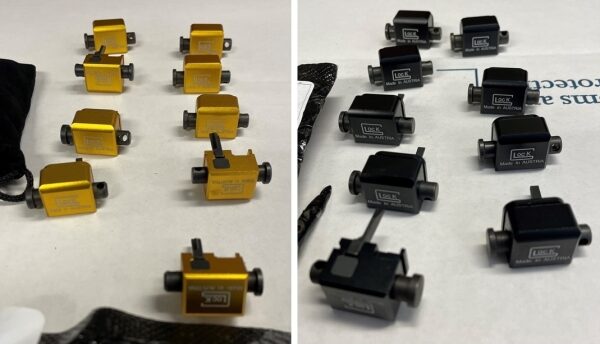For years, the spotlight on 3D printing’s potential for firearm production has revolved around fully 3D printed guns. However, the attention has now shifted to a far smaller, cheaper, and potentially more lethal mechanism: the machine gun conversion device (MCD). These tiny, often 3D printed components are becoming considered a more serious threats, according to authorities. Easy to manufacture and illegal for decades, MCDs can turn a semi-automatic firearm into a fully automatic weapon—delivering hundreds of rounds with a single pull of the trigger. This emerging trend has prompted the Bureau of Alcohol, Tobacco, Firearms and Explosives (ATF) and the U.S. Department of Justice to take quick action.

A switch “claiming” to be a Glock switch, but in reality, Glock never manufactured switches. Image courtesy of the U.S. Attorney’s Office.
The Rise of MCDs
MCDs, also known as “switches” or “auto sears,” are small components—usually made from metal or plastic—that can be easily attached to a handgun or rifle to convert it from semi-automatic to fully automatic. While possessing or manufacturing MCDs is illegal in the U.S., their production has exploded in the last two years, largely because it is very easy to create them with 3D printers, and they are often sold online or printed at home.
According to authorities, these devices are now becoming the most frequently recovered illegal firearm modification in the U.S. The ATF says there has been a 570% increase in MCD recoveries over the past decade.
Recognizing the growing threat, federal authorities, including U.S. Deputy Attorney General Lisa Monaco and ATF Director Steven Dettelbach, held a critical meeting on September 6, 2024. The event, which featured opening remarks by Monaco, Dettelbach, and U.S. Attorney Christopher Kavanaugh, brought together members of the additive manufacturing industry, academia (including Dartmouth College and Wichita State University), Oak Ridge National Lab, and law enforcement to address the growing dangers of MCDs.
Though much of the meeting was held behind closed doors, the public portion pointed to the need for collaboration to prevent the misuse of 3D printing technology to make MCDs. Although the representatives from the 3D printing industry were not named, Monaco acknowledged their presence.
“Technological developments provides tremendous positive value to our country, but it’s its misuse that we’re here today to try and get a handle on,” said Dettelbach. “Decades ago, Congress banned, except in very limited circumstances, new machine guns, and if you had told folks in law enforcement that in 2024, machine guns would be a major threat to public safety, I think they would have rolled their eyes at you in disbelief. Yet here we are in this room, and everywhere I go around the country, I talk to law enforcement, I listen to them, and they all tell me the same thing: that pounding repetitive sound of automatic weapon fire has hit the streets of this nation like jackhammers, and it has shattered so many lives.”
A Brief History
Machine gun conversion devices aren’t new; they’ve been illegal since the Firearm Owners Protection Act (FOPA) of 1986. The act made it illegal for civilians to possess or manufacture machine guns or parts, except in highly regulated cases. In the past, MCDs were difficult to get and primarily found in the hands of organized criminal groups. However, with the rise of affordable and accessible 3D printing, these once-rare devices are now easier to produce, leading to a spike in their use across various states linked to violent crimes and gang activity.
While the right to bear arms remains protected under the Second Amendment, the use of MCDs presents a unique potential danger to public safety, pointed out Dettelbach. So while owning firearms, including semi-automatic guns, is still legal in the U.S. under federal law, the moment a firearm is modified with an MCD, it becomes a machine gun, making its possession, sale, or production a serious felony with penalties including up to 10 years in prison and a $250,000 fine.
During shootings where MCDs are used, the number of rounds fired and fatalities often spikes, turning simple street incidents into mass shooting scenes, explains Monaco. This has led both federal law enforcement and local police departments to make MCDs a priority.
Government Response
Recognizing the growing danger of MCDs, the Justice Department has launched three initiatives to combat the spread of these illegal devices. Most notably, Monaco announced the creation of the ANTI-MCD (Action Network to Terminate Illegal MCDs) task force, co-chaired by the ATF and U.S. Attorneys. The initiative will boost tracking, prosecution, and law enforcement training on identifying and combating MCD offenses.
In addition, the Justice Department is focusing on ramping up prosecutions of MCD violations across the country.
“I’m directing all 94 U.S. Attorneys’ Offices to prioritize MCD prosecutions by employing comprehensive and district-specific MCD enforcement strategies,” said Monaco. “Over the next 90 days, each U.S. Attorney’s office will meet with federal, state, local, Tribal, and territorial law enforcement partners to identify promising MCD-related enforcement practices. Many U.S. Attorneys are already doing this.”
Finally, the ATF has rolled out the National MCD Training Initiative to help law enforcement officers and prosecutors learn about the fast-changing designs of MCDs, many of which are being shared in online 3D printing communities. This training will be regularly updated to make sure the ATF and local police stay ahead of the criminals making these devices.
One example of the government’s response comes from Project Switch Off, a program launched in Oklahoma City that has led to nearly 40 prosecutions in less than a year. The project includes training nearly 500 local police officers to identify MCDs and prosecute individuals involved in their use.
Law enforcement efforts are starting to show results. As one police officer in Oklahoma City reported to Monaco, “Gang members are scared to death to use the switches because their buddies are going to federal prison.” This shift in criminal behavior is “a powerful example of how working together we can make a difference for our communities,” went on to say Monaco to attendees.
While local efforts like Project Switch Off are making strides, the federal government is also tackling the issue at a larger scale. In a major effort to disrupt the illegal distribution of machine gun conversion devices, federal authorities recently seized over 350 website domains that were being used to import MCDs and silencers from China. These devices were often mislabeled as “toys” or “necklaces” to evade detection. The importation of MCDs and silencers from overseas not only violates the National Firearms Act but shows how the problem is becoming more international, and authorities have concluded that as MCDs continue to increase, the stakes have never been higher.

One of the more than 350 websites seized by Federal authorities used to import illegal switches from China. Image courtesy of the U.S. Attorney’s Office.
Subscribe to Our Email Newsletter
Stay up-to-date on all the latest news from the 3D printing industry and receive information and offers from third party vendors.
Print Services
Upload your 3D Models and get them printed quickly and efficiently.
You May Also Like
AFRL Funds Flexible 3D Printed Antenna Arrays With Real Time Correction
Washington State University (WSU), the University of Maryland, the University of British Columbia, and Boeing researchers have completed work on additively manufactured antenna arrays, which have been published in Nature...
Incus Releases Hammer Pro25, Proving Innovation Doesn’t Need to Be Flashy
Viennese firm Incus is showcasing the new Hammer Pro25. That system is meant to be a scalable Slurry SLA unit created for continuous manufacturing (Incus uses DLP but we refer...
3D Printing News Briefs, October 25, 2025: Strategic Investment, Inner Ear Organoids, & More
In this weekend’s 3D Printing News Briefs, we’ll start off with some business news, as Xact Metal announced continued double digit growth in Q2 and Q3 of 2025, and the...
Safran Buys Three Lithoz 3D Printers for Casting Cores
Safran Aircraft Engines has bought three Lithoz CeraFab System S65 for its Gennevilliers site. Gennevilliers is a main site for Safran to make cast and forged parts for aero engines....



































